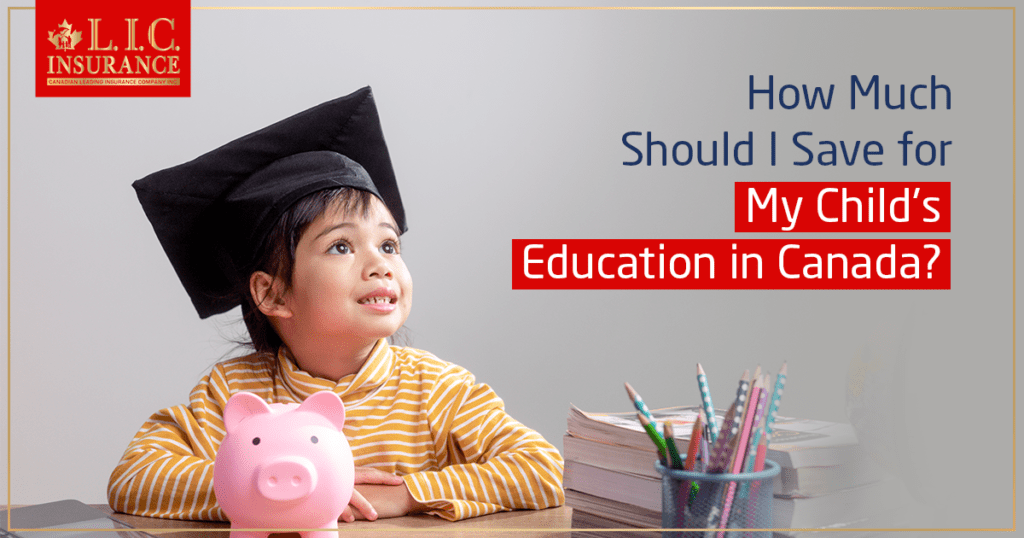- How Much Should I Save for My Child’s Education in Canada?
- The Rising Costs of Education in Canada
- Starting With a Goal: Estimating Future Costs
- Understanding the Role of RESPs
- How Much to Save
- Maximizing Your Savings with RESP
- Overcoming Common Challenges
- Conclusion: Take action today for your child’s post-secondary education

Understanding how much your child’s education will cost in Canada can be difficult. With the ever-increasing tuition fees and living expenses, starting early and being strategic about saving is more important than ever. But just how much should you save? Let’s break down the essentials, incorporating the role of Registered Education Savings Plan (RESP) providers and how to register an education-saving plan in Canada to secure your child’s educational future.
The Rising Costs of Education in Canada
Before we know the numbers, it’s necessary to acknowledge the rising education costs in Canada. Over the past few decades, tuition fees have significantly increased, with university students now paying around 40% more than they did ten years ago. This spike doesn’t even include the cost of books, supplies, living expenses, and other miscellaneous costs associated with a post-secondary education.
Starting With a Goal: Estimating Future Costs
To begin, estimate the future cost of your child’s education. Consider factors such as the type of institution (public vs. private), the program of study, and whether they will live at home or move out. While these numbers can feel overwhelming, having a target in mind is the first step in creating a practical savings plan.
Understanding the Role of RESPs
One of the most effective tools at your disposal is the Registered Education Savings Plan (RESP). These accounts are specifically designed to help Canadian parents save for their children’s post-secondary education. One of the key benefits of an RESP is the government grants it attracts. For example, the Canada Education Savings Grant (CESG) matches 20% of your annual contributions up to $500 per year for each child, with a lifetime maximum of $7,200. This feature alone makes registering an education-saving plan in Canada a no-brainer for parents.
Research is vital when selecting Registered Education Savings Plan providers. Look for providers who offer flexible investment options, low fees, and excellent customer service. The right provider can make a significant difference in the growth of your savings. Find out everything about RESP in Canada if you want to know more.
Find Out: Why choose an RESP?
Find Out: The importance of RESP
How Much to Save
So, how much should you actually save? The answer varies depending on several factors, including the age of your child when you start saving, your financial capacity, and the expected cost of their chosen program. However, financial experts often recommend saving between $200 to $300 per month per child from birth to cover a significant portion of their post-secondary education costs in Canada.
Breaking Down the Numbers
You should start saving $250 per month from when your child is born until they turn 18. Assuming an average annual return of 5% from your investments in the RESP, you could accumulate approximately $80,000 by the time they’re ready for college or university. This amount can cover a substantial portion of tuition fees, books, and living expenses, depending on the program and location.
Adjusting Your Savings Plan
It’s important to review and adjust your savings plan regularly. Consider increasing your contributions if you receive a bonus, an income increase, or a financial windfall. Conversely, adjusting your contributions is okay if you hit a financial bump. The main thing is consistency and making regular contributions, no matter how small.
Maximizing Your Savings with RESP
Leverage Government Grants: Start by harnessing the power of the Canada Education Savings Grant (CESG), which adds 20% to your contributions up to $500 per child annually. But don’t stop there! Dive into provincial grants available in your area to amplify your savings even more.
Explore Provincial Grants: Additional provincial grants might be up for grabs depending on where you live in Canada. These grants can boost your RESP, so research and apply for any that you qualify for to maximize your savings.
Choose the Right RESP Provider: Not all Registered Education Savings Plan providers are created equal. Look for one that aligns with your financial goals, offers a robust selection of investment options, and has a strong track record of performance. Register your education-saving plan in Canada with a provider that understands your needs.
Invest Wisely: With the help of your RESP provider, invest your contributions in a mix of stocks, bonds, and mutual funds tailored to your risk tolerance and the time frame until your child starts post-secondary education. A well-diversified portfolio can grow your savings more efficiently.
Regularly Review Your Plan: Keep in touch with your Registered Education Savings Plan provider to review and adjust your investment choices as needed. Market conditions change, and so will your financial situation and goals. Regular reviews ensure your RESP stays on track to meet your child’s education funding needs.
Following these steps and actively managing your Registered Education Savings Plan with the right provider can significantly enhance your child’s education fund. Remember, the earlier you start, the more you can take advantage of compound growth and government contributions, making your savings journey more effective and less stressful.
Get The Best Insurance Quote From Canadian L.I.C
Call 1 844-542-4678 to speak to our advisors.

Overcoming Common Challenges
Trim Non-Essentials: Review your budget to cut back on unnecessary expenses. Even minor reductions can contribute significantly to an RESP over time.
Boost Income: Consider side gigs or sell unused items. Extra earnings can directly support your child’s education fund.
Leverage Government Grants: Enrolling in a Registered Education Savings Plan in Canada unlocks access to government grants that match a portion of your contributions, increasing your savings.
Automate Contributions: Set up automatic deposits with Registered Education Savings Plan providers to ensure consistent savings without the hassle.
Community Contributions: Encourage family and friends to contribute to the RESP on special occasions, enhancing your savings effort.
Find Out: How RESP is a future proof plan for your child’s education
Conclusion: Take action today for your child’s post-secondary education
There is no one correct answer to the question of how much to save for your child’s education in Canada. However, starting early, making regular contributions to an RESP, and taking advantage of government grants can put you on the right path. Remember, yesterday was the best time to start saving; the next best time is today.
Selecting the right Registered Education Savings Plan providers and registering an education savings plan in Canada are necessary to secure your child’s educational future. By taking action now, you’re not just saving money but investing in your child’s dreams and aspirations.
Please leave comments, share your experiences, and ask questions below. Let’s make this journey towards saving for our children’s education a collective effort. Your future self—and your children—will thank you.
Find Out: What happens to RESP if you leave Canada?
Find Out: Can you transfer RESP to RRSP?
Get The Best Insurance Quote From Canadian L.I.C
Call 1 844-542-4678 to speak to our advisors.
Faq's
A Registered Education Savings Plan (RESP) is a savings account that helps parents, family members, and friends save for a child’s post-secondary education. The government supports these accounts by adding grants to the money you save, making it a powerful way to grow your education fund.
Yes, Registered Education Savings Plans (RESPs) are worth considering if you’re planning for your child’s education in Canada. RESPs help you save for education while taking advantage of tax benefits and government grants like the Canada Education Savings Grant (CESG). This can significantly increase your savings and give your child a solid financial foundation for post-secondary education.
When you register an education saving plan in Canada, you contribute money into the account, which can grow tax-free until it’s withdrawn. The government also contributes with grants based on your contributions, up to a certain limit. When your child enrolls in a qualifying post-secondary education program, the funds can be withdrawn to pay for their education expenses. The withdrawals include both your contributions, which are not taxed, and the earnings on those contributions, which are taxed in the hands of the student, typically at a lower rate.
RESP withdrawals are partially taxable. When you withdraw money from an RESP for education purposes, the payments are split into two parts: the Post-Secondary Education (PSE) withdrawals, which are the contributions you made and are not taxable, and the Educational Assistance Payments (EAPs), which include the investment earnings and government grants. EAPs are taxable in the hands of the student, who often pays little to no tax due to their lower income.
Your contributions to an RESP are not tax-deductible, meaning you don’t get a tax break when you put money in. However, the investment growth within the RESP is tax-free until it’s withdrawn. This allows your savings to grow more efficiently over time.
The best Registered Education Savings Plan provider or promoter for you depends on your specific needs, including investment options, fees, and customer service. Researching and comparing different providers is essential to find one that suits your financial goals and preferences. Consulting with a financial advisor can also help you make the perfect decision.
In Ontario, as in the rest of Canada, the best RESP depends on your individual circumstances and needs. Look for Registered Education Savings Plan providers that offer competitive fees, a wide range of investment choices, and excellent customer service. Also, consider providers who are knowledgeable about provincial programs like the Ontario Student Assistance Program (OSAP) that might interact with your RESP savings.
When choosing Registered Education Savings Plan providers, consider factors like their fees, investment options, customer service quality, and reputation. Selecting a provider that aligns with your financial goals and provides transparent, understandable information is especially important.
To register an education-saving plan in Canada, you must choose a provider first. Then, you’ll provide the necessary documents, such as your child’s birth certificate or SIN (Social Insurance Number) and your own identification. The provider will guide you through the registration process, which includes choosing the type of RESP account and how you wish to invest the funds.
Yes, you can change Registered Education Savings Plan providers if you’re not satisfied with the performance or fees of your current plan. However, it’s essential to check if there are any transfer fees or penalties involved before making the switch.
The government contributes through the Canada Education Savings Grant (CESG) by matching 20% of your annual contributions, up to $500 per child per year, with a lifetime maximum of $7,200 per child. Additional grants may also be available depending on your province and family income.
If your child decides not to pursue post-secondary education, several options exist. You can keep the RESP open for up to 36 years in case they change their mind. Alternatively, you can transfer the funds to another child’s RESP or transfer the earnings to your RRSP, subject to certain conditions and limits. The contributions you made can be withdrawn without penalty, but the government grants will need to be returned.
Like any investment, RESPs have risks, mainly related to the market performance of the investments chosen within the plan. However, the risk can be managed by selecting a diversified investment portfolio and adjusting the investment strategy as your child approaches college or university age.
Contributing regularly to your RESP is advisable to take full advantage of compounding interest and government grants. Many families find setting up automated monthly contributions helpful to ensure they’re consistently saving for their child’s education.
Yes, you can open an RESP for a child who is not your own. Grandparents, other relatives, or even friends can register an education-saving plan in Canada for any child. You’ll just need the child’s SIN and approval from the child’s parent or guardian to start saving for their future education.
Registered Education Savings Plan providers offer a variety of investment options for your RESP, including mutual funds, stocks, bonds, and GICs (Guaranteed Investment Certificates). Selecting investments that match your risk tolerance and investment timeline is necessary.
To withdraw money from an RESP, inform your Registered Education Savings Plan provider that your child has enrolled in a qualifying post-secondary education program. You’ll need to provide proof of enrollment, and then you can start withdrawing funds. These withdrawals are called Educational Assistance Payments (EAPs) and are taxable for the student, who typically has a lower income.
Yes, there is a penalty for over-contributing to an RESP. The lifetime contribution limit per child is $50,000, and contributions above this amount are subject to a 1% per month penalty on the excess amount until it is withdrawn.
To maximize government grants, try to contribute at least $2,500 per year to your child’s RESP. This ensures you receive the maximum Canada Education Savings Grant (CESG) of $500 annually. Also, keep an eye on any additional grants your child might be eligible for based on your family income or your province of residence.
If you’re unhappy with the service from your Registered Education Savings Plan provider, consider discussing your concerns with them directly first. If the issue persists, you can transfer your RESP to another provider. Be sure to inquire about any potential fees or charges involved in transferring your RESP.
Yes, RESP funds can be used to cover a wide range of education-related expenses, including tuition, books, and living expenses. The flexibility of RESP withdrawals allows students to use the funds for various needs while they are enrolled in a post-secondary education program.
If your child opts out of school, you can transfer the RESP to another sibling, withdraw your contributions tax-free, use it for non-university education programs, or close the RESP, returning any grants and potentially transferring earnings to an RRSP. Choosing the right Registered Education Savings Plan provider in Canada offers your child’s future flexibility.
Yes, RESP funds can be used for rent and other living expenses while the beneficiary is enrolled in a qualifying post-secondary education program. This flexibility makes RESPs a valuable tool for covering the comprehensive costs associated with higher education.
By asking the right questions and making wise decisions, you can effectively explore the world of Registered Education Savings Plans (RESPs) and ensure a bright educational future for your child in Canada. Remember, the earlier you start, the more you can benefit from the growth of your investments and government contributions.
The above information is only meant to be informative. It comes from Canadian LIC’s own opinions, which can change at any time. This material is not meant to be financial or legal advice, and it should not be interpreted as such. If someone decides to act on the information on this page, Canadian LIC is not responsible for what happens. Every attempt is made to provide accurate and up-to-date information on Canadian LIC. Some of the terms, conditions, limitations, exclusions, termination, and other parts of the policies mentioned above may not be included, which may be important to the policy choice. For full details, please refer to the actual policy documents. If there is any disagreement, the language in the actual policy documents will be used. All rights reserved.
Please let us know if there is anything that should be updated, removed, or corrected from this article. Send an email to [email protected] or [email protected]

